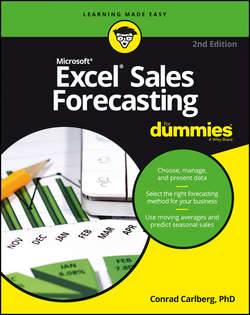Excel Sales Forecasting For Dummies

Реклама. ООО «ЛитРес», ИНН: 7719571260.
Оглавление
Carlberg Conrad. Excel Sales Forecasting For Dummies
Introduction
Part 1. Understanding Sales Forecasting and How Excel Can Help
Chapter 1. A Forecasting Overview
Chapter 2. Forecasting: The Basic Issues
Chapter 3. Understanding Baselines
Chapter 4. Predicting the Future: Why Forecasting Works
Part 2. Organizing the Data
Chapter 5. Choosing Your Data: How to Get a Good Baseline
Chapter 6. Setting Up Tables in Excel
Chapter 7. Working with Tables in Excel
Part 3. Making a Basic Forecast
Chapter 8. Summarizing Sales Data with Pivot Tables
Chapter 9. Charting Your Baseline: It’s a Good Idea
Chapter 10. Forecasting with Excel’s Data Analysis Add-in
Chapter 11. Basing Forecasts on Regression
Part 4. Making Advanced Forecasts
Chapter 12. Entering the Formulas Yourself
Chapter 13. Using Moving Averages
Chapter 14. Changing Horses: From Moving Averages to Smoothing
Chapter 15. Smoothing: How You Profit from Your Mistakes
Chapter 16. Fine-Tuning a Regression Forecast
Chapter 17. Managing Trends
Chapter 18. Same Time Last Year: Forecasting Seasonal Sales
Part 5. The Part of Tens
Chapter 19. Ten Fun Facts to Know and Tell about Array Formulas
Chapter 20. The Ten Best Excel Tools
About the Author
Take Dummies with you everywhere you go!
WILEY END USER LICENSE AGREEMENT
Отрывок из книги
You wouldn’t have pulled this book off the shelf if you didn’t need to forecast sales. And I’m sure that you’re not Nostradamus. Your office isn’t filled with the smell of incense and it’s not your job to predict the date that the world will come to an end.
But someone – perhaps you – wants you to forecast sales, and you find out how to do that here, using the best general-purpose analysis program around, Microsoft Excel.
.....
So with moving averages, you take account of the signal – the fact that you sell more ski boots during certain months and fewer during other months, or that you sell more beer on weekends than on weekdays. At the same time you want to let the random noises – also termed errors – cancel one another out. You do that by averaging what’s already happened in two, three, four, or more previous consecutive time periods. The signal in those time periods is emphasized by the averaging, and that averaging also tends to minimize the noise.
Suppose you decide to base your moving averages on two-month records. That is, you’ll average January and February, and then February and March, and then March and April, and so on. In that case you’re getting a handle on the signal by averaging two consecutive months and reducing the noise at the same time. Then, if you want to forecast what will happen in May, you hope to be able to use the signal – that is, the average of what’s happened in March and April.
.....